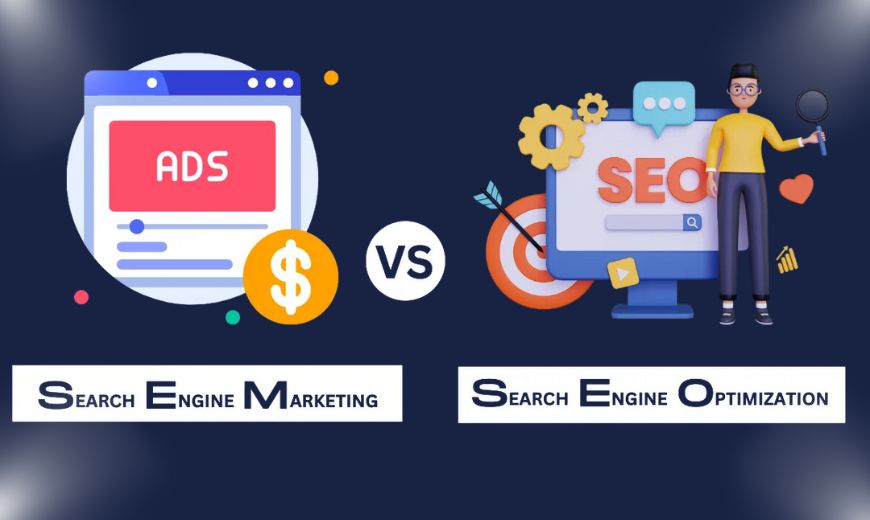
In the expansive realm of digital marketing, two acronyms often find themselves in the spotlight: SEO and SEM. While they may sound similar, they serve distinct purposes in boosting online visibility and driving traffic to websites. Understanding the disparity between SEO (Search Engine Optimization) and SEM (Search Engine Marketing) is crucial for crafting an effective digital marketing strategy.
Is SEM and SEO the Same?
To clear the air from the get-go: no, SEM and SEO are not the same. While they both aim to enhance a website’s visibility on search engine results pages (SERPs), their approaches and methodologies differ significantly.
Difference between search engine marketing and search engine optimization
What is SEO (Search Engine Optimization)?
It involves optimizing a website for both users and search engines to improve its ranking and attract relevant traffic to the site.
In this process, a webmaster or SEO professional implements all the recommended white-hat techniques on the website. For instance, Google evaluates factors such as website loading speed, security, structure, content quality, and user experience when determining a website’s ranking on its search engine.
Therefore, during website SEO, all these elements are managed. However, the ultimate goal is to boost website ranking and attract a larger audience.
Furthermore, all the efforts invested in SEO aim to generate organic traffic without resorting to advertisements or PPC campaigns.
Typically, there are three key aspects of search engine optimization:
- On-Page SEO: This focuses on optimizing elements directly within the website to enhance search engine visibility. It encompasses improving loading speed, addressing technical issues, crafting high-quality content, utilizing meta tags and descriptions, incorporating proper heading tags, and enhancing website security.
- Off-Page SEO: This involves activities conducted outside the website to improve its search engine ranking. It primarily revolves around building or earning backlinks from authoritative websites within relevant niches. Techniques such as guest blogging, article submission, classified submission, image submission, and social bookmarking are employed to acquire these backlinks.
- Technical SEO: This pertains to optimizing the technical aspects of a website to improve its search engine performance. It encompasses various factors such as optimizing loading speed, ensuring reliable web hosting, implementing efficient coding practices, securing an SSL certificate, and adhering to Google’s Accelerated Mobile Pages (AMP) guidelines.
These three components collectively contribute to the overall effectiveness of an SEO strategy, ensuring better visibility and rankings on search engine results pages (SERPs).
SEM, or Search Engine Marketing, plays a pivotal role in digital marketing, encompassing various strategies to promote businesses on search engines. Marketing on search engines entails two primary approaches.
What is SEM (Search Engine Marketing)?
Search Engine Marketing (SEM) is a digital marketing strategy aimed at increasing the visibility of a website in search engine results pages (SERPs) through paid advertising. Unlike Search Engine Optimization (SEO), which focuses on organic traffic, SEM involves the use of paid tactics to appear in front of potential customers actively searching for products or services.
The primary platforms for SEM are Google Ads and Bing Ads, where advertisers bid on keywords relevant to their business. These ads are typically displayed at the top or bottom of the search results, marked as sponsored content.
Key Aspects of Search Engine Marketing
- Keyword Research: Identifying the right keywords is crucial for a successful SEM campaign. This involves understanding what terms potential customers use when searching for products or services related to your business. Tools like Google Keyword Planner can help in discovering high-performing keywords with a good balance of search volume and competition.
- Ad Creation: Crafting compelling ad copy is essential. Ads must be relevant, engaging, and include a clear call to action (CTA). The ad copy should match the keywords and target the audience’s intent, whether it’s informational, navigational, or transactional.
- Bid Management: Effective bid management ensures that your ads appear in optimal positions without overspending. This involves setting maximum bids for each keyword and adjusting them based on performance metrics and budget constraints. Automated bidding strategies can also be employed to optimize bids in real-time.
- Quality Score: Search engines like Google assign a Quality Score to each ad, which influences the ad’s placement and cost-per-click (CPC). The Quality Score is determined by factors such as the ad’s relevance to the keyword, the click-through rate (CTR), and the landing page experience. Higher Quality Scores can lead to better ad positions and lower costs.
- Performance Tracking and Optimization: Continuous monitoring and optimization of SEM campaigns are necessary for success. This includes analyzing metrics like impressions, clicks, CTR, and conversion rates.
By leveraging these key aspects, businesses can effectively use SEM to drive targeted traffic, increase brand awareness, and achieve their marketing goals.
What is the Relationship Between SEO and SEM?
While SEO and SEM operate independently, they are not mutually exclusive. In fact, they often complement each other in a holistic digital marketing strategy. SEO lays the foundation for long-term organic growth, gradually improving a website’s ranking and driving sustained traffic over time. On the other hand, SEM provides instant visibility through paid advertisements, making it an effective short-term solution for generating immediate traffic and leads.
SEO & SEM Comparison: Which is Better for Business?
The choice between SEO and SEM depends on various factors, including budget, timeline, and marketing objectives. For businesses looking for quick wins and immediate visibility, SEM can be an effective strategy to drive targeted traffic and generate leads. However, it requires careful keyword selection, ad targeting, and budget management to ensure a positive return on investment (ROI).
On the other hand, SEO offers long-term benefits and sustainability, as it focuses on building organic authority and relevance over time. While it may take longer to see significant results, the investment in SEO pays off in the form of consistent organic traffic and improved search engine rankings. Moreover, SEO is inherently more cost-effective in the long run, as it does not entail ongoing payments for ad placement.
In conclusion
While SEO and SEM serve distinct purposes in digital marketing, they are both essential components of a comprehensive strategy. By leveraging the strengths of both approaches, businesses can maximize their online visibility, drive targeted traffic, and ultimately, achieve their marketing goals in the competitive landscape of the digital realm.



